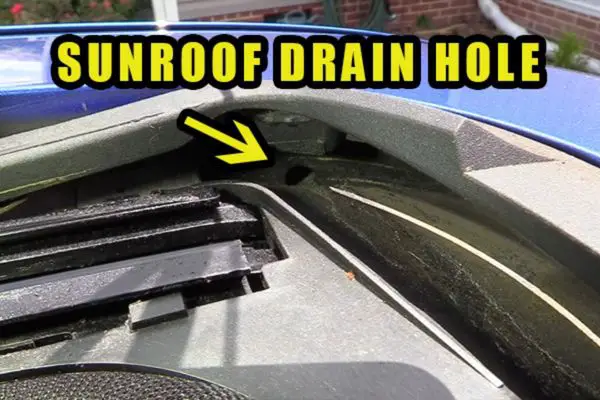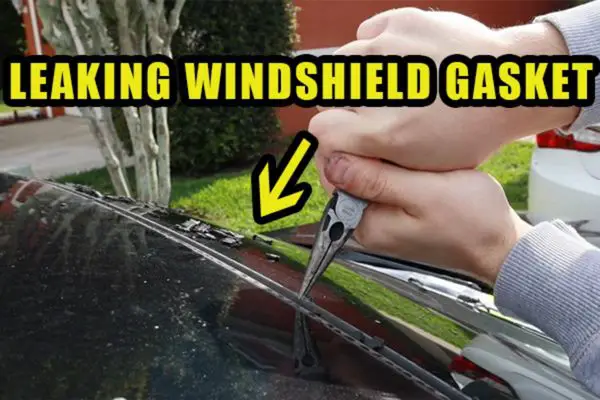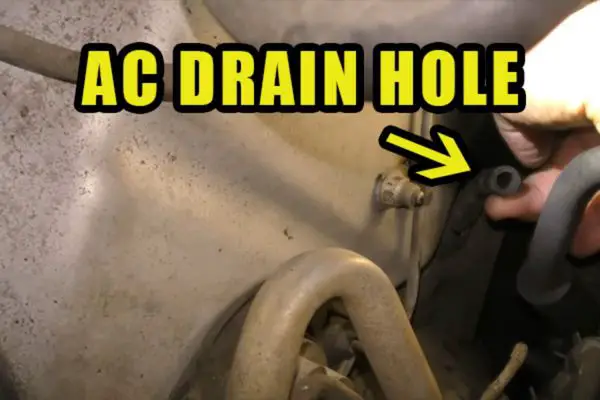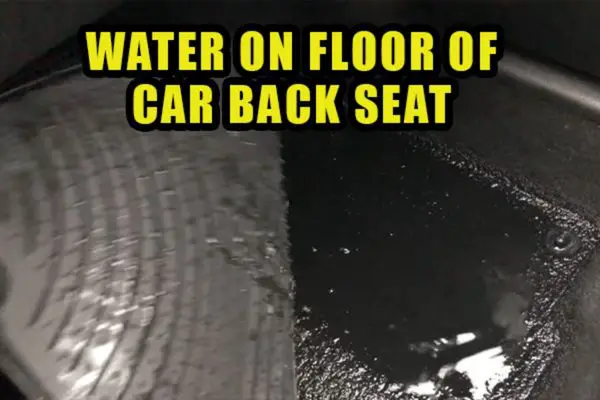The main reasons behind the water on floor of car back seat are leaking sunroof, failing windshield gaskets, leaking doors, clogged wiper cowl drains, air condition leaks, malfunctioning heater core, and clogged firewall seals.
More often than not, the leak will be a result of a clogged drain tube or AC issues. You can fix them by identifying the source of the leaking and cleaning the clogged areas.
Keep reading this article to find out how you can do it in detail. We’ll also discuss how to prevent in from happening in the future and how you can dry the floorboard of your vehicle. Let’s dive in!
Table of Contents
Why Water On The Floor Of Car Back Seat [Reasons + Solutions]
Are you wondering why is there water in the backseat of my car? We’ll look at the most common causes of it in this section.
Note: You can also read how to fix sealing motor oil leaks from the outside.
1. Leaking Sunroof
All the cars that have a sunroof have a seal. They are not tight enough to hold the water on their own and that’s why there is a mechanism to drain the water. It’s done by the holes in the metal frame in the sunroof. This part is called the sunroof tray.

The water that’s collected by the sunroof during rain is transferred to the ground under the vehicle. But the holes in the sunroof tray can get easily clogged due to leaves, branches, or debris. With nowhere else to go, the water can now enter your cabin area and wet the floor of your seat.
Solution:
If you see water on the floor of car’s back seat when raining due to a leaking sunroof, there are many ways you can go about fixing it. The first thing you need to do is understand why the leak is happening. If the water goes to your cabin area because of the build-up of dirt, you can clean it and solve the problem.
Start by opening the sunroof to access the drains. Clean the seal of the sunroof as the presence of dirt can keep it from closing properly. Now, point an air compressor towards the drain holes so that the clog comes out through the other side.
You can use a water hose if you don’t have an air compressor. It’s a good idea to clean the rubber seal of the sunroof even if it’s not dirty and the leak is caused by the drain holes. Doing so can increase its lifespan and prevent other issues in the future.
2. Failing Windshield Gaskets
Another potential reason behind having water in the back seat floorboard is when the rainwater passes through the small holes in your car like the windows and windshields. In the old days, manufacturers used to put a rubber seal between the frame of the car and the glass.

But it has been replaced with butyl tape as rubber can go bad quickly. If you have a car with rubber seals, water can get into your car as the rubber seal can dry up with time. They can become brittle, get damaged, and allow for leaks. Rainwater will find its way into your vehicle if the weather stripping is bad.
If you live in a cold area, your windshield can also get damaged due to frozen water. As water expands when it freezes, the rain can get inside the seal and damage the seal.
Solution:
If you no longer want to think about why is my back seat floor wet and solve this problem ASAP, you can start by applying a sealant on the leak. It doesn’t matter if you use butyl, silicone, or urethane as long as it does a great job at covering the leak and not letting water get through it.
Another alternative approach to solve this issue is to replace the rubber seal altogether instead of just fixing the leak. It’s better to hire a mechanic for this job than to do it yourself. Make sure that the weather stripping in your car is in great condition if you intend to park it outside.
3. Leaking Doors
Thinking that the doors of a vehicle are airtight is a common misconception that many people have. Water can fall from the seals on the sides of the doors into the holes at the bottom. It happens when these seals were out and can no longer do a good job of keeping the water at bay.
The water that’s collected in the drain can get out but it won’t happen if the drain holes are clogged as well. A visual inspection of the bottom part of the door should tell you if it’s blocking the water from going out.
Solution:
If you find the drain holes that are supposed to get the water out of your car, you need to start by cleaning them. That’ll start to drain the water from your vehicle. If the rubber seals have worn off, you need to replace them too. Installing it is easy and you’d be fine doing it on your own.
4. Clogged Wiper Cowl Drains
There are some drains at the base of the wiper arms that let the water in. When the water is collected in a tray, it’s discarded at the rear of the front wheels. But when the drains are clogged, this process will no longer work effectively.
Water can build up in the wiper cowl drains and lead to significant damage. Mud, frozen water, and snow are the usual things that block a wiper cowl drain either at the top or at the base.
Solution:
If clogged wiper drains are causing the issue, you can easily solve this problem by cleaning them. Follow these steps to do it:
- Locate the wiper cowl drain after popping the hood off.
- Unscrew the wipers and the cowl.
- Take the wipers out using a crowbar.
- Remove the cowl from the panel under the wipers.
- Once you have access to the drain, remove any dirt that’s clogging it.
- Clean the drains by blowing compressed air in them.
- If there are any stubborn pieces of dirt that aren’t getting out easily, you can use a coat hanger to get them out.
- Install the cowl and the wipers again after completing the cleaning process.
5. Air Condition Leaks
If there has been a water leak inside the car and you’re sure that there has been no rainfall recently, the leak can potentially come from the AC. The HVAC system in your car does the job of giving you the desired temperature inside your car.
But when something goes wrong with it, you can end up with water in the cabin area. The most common culprit that’s usually at fault when the issue is with your AC is the AC evaporator drain tube. The job of the evaporator is to draw the humid air out of your car.

It’s supposed to drain the water when you’re driving. But when it gets clogged, the condensation will not have a place to go and the water will leak into your vehicle. The most obvious sign of having a bad AC drain tube is if you see the water leaking inside the car when AC is on and not at other times.
Another sign of the drain tube being the issue is if the water leaks are at the passenger side carpet. It’s extremely dangerous as the electrical components of the HVAC system can be damaged when they come in contact with water.
Besides the drain tubes, the seals can also wear out and the evaporator core can also be leaking. Dirt, leaves, and debris can get to it if they pass through the AC and result in leaking water and a puddle of water on the floor of the back seat of your car.
Solution:
Depending on the reason behind the water on the floor in the back seat of the car, you may have to take different approaches. As the most common one is the drain tube, let’s look at how to deal it with first. Follow these steps to remove a clog in your AC drain:
- Park your car on a flat surface and turn off the HVAC system.
- Take a piece of wire, straighten it, and bend it on one end so that you can use it as a hook.
- Locate the AC drain line.
- Use jack stands if required as it’s most likely to be located outside your vehicle close to the condenser.
- Glide the piece of wire into the drain line and use it to pull out any dirt or debris you can find in there.
- You can use compressed air to remove any remaining dirt inside it.
Doing these things will unclog it and it should run back to normal. You can replace the AC rubber seals if they’re damaged easily and it shouldn’t be too expensive or difficult. But if the evaporator core has gone bad, you have no other option but to get a new one and install it.
6. Malfunctioning Heater Core
Just like the AC, issues with the heating system can also create problems and leave you wondering why is there water in the back seat of the car. The heater core in your car acts like a small radiator that uses the hot coolant inside the engine to raise the temperature in the cabin area.

But with time, the heater core can get bad and when it does, coolant can leak through it and end up on the floor of your car. But, how can you tell when the heater core has gone bad?
There are many signs you can be on the lookout for if you suspect having a bad heater core. Here are the most common ones:
Not Enough Heat
A faulty heater core will not be able to warm up your car’s cabin as it used to in the past. As it won’t be operating at full effectiveness, you’ll feel a lack of heat in your car. It can also happen due to any obstruction in the flow of the coolant to the heater core.
Formation Of Fog
You may see the formation of fog on the windshield if the heater core is leaking. That’s because the coolant will travel into the unfreeze vents in this situation. If it’s accompanied by a sweet smell, you can almost be certain that the coolant is leaking through it.
Coolant Issues
Normally, you’d see water on your floorboard if it’s due to issues in the AC or other seals. But when the heater core goes bad, you’ll see coolant. The level of coolant will also be low as it’ll be leaking. The absence of coolant will also lead to your engine overheating and cause severe damage.
Solution:
If you noticed these signs and you can confirm that you have a leaking heater core, you need to replace it. Unfortunately, replacing them can be pretty expensive and can cost between $1000 – $1400. You can expect to spend $450-$600 on parts and $550 – $800 on labor charges.
7. Leaking Firewall Seal
The firewall in a car separates the engine compartment from the one for passengers. It’s normally sealed with rubber grommets and silicon adhesives so that it can regulate the temperature and prevent any leaks.
If the seal gets broken for any reason, it’ll leak water into your car. There are also drains in the firewall that is supposed to get the water out. The leak can also be a result of clogged firewall drains.
Solution:
If the leak is coming due to a broken seal, you need to replace it. But if it’s caused due to the firewall drains being clogged by leaves or dust, you can simply clean it and solve your problem.
How To Identify The Leak
To do a car water leak repair properly and make sure that it doesn’t happen again, you need to correctly identify the source of the leak. Here are some methods you can use to do it:
Run The AC
Normally, the two major reasons behind water in your car are rainwater getting through the leak and issues with the HVAC system. If the car is leaking only when the AC is on, you can be certain that it’s coming from the AC.
Park your car in an area where rain can’t get to it. Leave the AC running for a while and come back later. If the water leaks, you’ve found the culprit.
Use Soap Water
If the leak doesn’t come from the AC, the most likely reason behind it is that rainwater is getting in through a leak in the car. Mix soap and water and pour it on a windshield to locate a leak from it. Start at the bottom and keep adding more soup if the water is running too fast.
Now, you can take a can of compressed air and spray it around the edges. If you see the soapy liquid bubbling up, you’ve found where the leak is coming from. You can also use the same method for locating leaks from the sunroof or doors of your car.
There’s a high likelihood that the door seals are broken if water gets into your car only when you’re on a slop. You can also check the drains one by one. Pour water into each of them and see if it comes out to the other end. That should help you identify what’s causing the issue.
How To Remove Water From The Floor Of A Car
You already know how to seal the leaks so that your car doesn’t get drenched in the water again. But what about getting the water out that’s already in your car? It’s not a complicated task to remove it.
Remove as much of the water as you can manually at first. Then, you can use towels or do a wet/dry vacuum. Use a disinfectant when mopping the floor to get rid of any unwanted bacteria or mold growth.
Leave the car doors open in your car and place a fan such that the air blows through the car floor, dries it, and gets out on the other side. The moisture present in the upholstery should go away if you leave it like that for a day.
If the issue is more serious and it’s not drying up, you can remove the carpet and put it in the sun to dry. After putting it back in, use a dehumidifier to get the car to smell clean again.
What Happens If You Don’t Remove The Water
The idea of leaving the water in your car sitting and collecting dust is not good, to begin with. But in case you’re not bothered about the water on the back floor of the car and you want to leave it as it is, keep in mind that it can cause a wide range of problems.
You’re better off getting rid of the water and sealing the leak to make sure it doesn’t happen. Here’s what will happen if you ignore it:
Mold And Mildew Growth
When there’s moisture anywhere, it’s a breeding ground for mold and mildew. If you avoid the water in the back seat of your car, mold can grow in it. Not only will it make your car smell bad but it can also be a health hazard for people who have allergies or weak immune systems.
Damage To Cushioning
Even if the padding in your car is made from durable materials, it won’t be able to resist moisture for too long. Not only will the upholstery be stained but it’ll also wear out with time. You’ll have to spend a lot to replace it later. So, it’s better to get the water out of your car right away.
Pest Infestation
If there’s a source of water in your car and you haven’t addressed the leak, pests can get into it in search of food and settle there. Depending on the size of the leak, it can attract bugs, cockroaches, and even rats.
FAQs:
What are some signs of a leaking sunroof?
Drips of water around the sunroof, water-stained headliners, and a musty odor in the cabin of your car are some common signs of a leaking sunroof.
How often should you check the drainage holes?
Many motorists avoid checking the drain holes unless there’s a leak. But it’s a good idea to vacuum the leaks every six months or so to prevent any water leaking issues in the long run.
What should you use to clean the drain holes?
Using a flexible wire that you can pass through the drain holes should be enough to remove any dirt from them. You can also use trombone cleaners that have little brush heads to do this job without causing any damage.
Can water damage car seats?
If your car is flooded with water and it stays for a while, it can not only damage the car seats but also leave a bad smell. You may have to replace the cushioning if the damage is too severe.
Conclusion
It’s frustrating to see water on the floor of the car’s back seat and it can take a lot of work to get it out and dry your carpet. But at least now you know the main reasons behind it and how you can prevent it from happening again.
We hope this guide will help you identify what’s causing the leak in your case and help you fix it. Don’t let the water sit in your car for too long as it can lead to mold and mildew growth. Leave a comment below if you have any questions about water being in your car’s back seat.


About John M
John contributed as a technical head at an automobile company just 2 years after his post-graduation in Automobile Engineering. He loves to lead a free life, so he left his job & started blogging. Now, he does research on every automotive problem, part & product and seeks a better solution & best products & shares his findings with his readers to help them as well as to minimize their struggle.